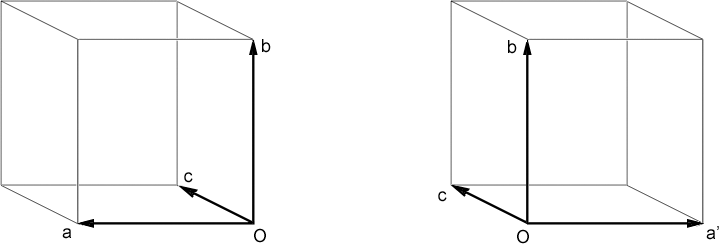A two-fold rotation changes the sign of two indices, while a mirror flips
just one sign. The allowable twin operations, expressed as (3x3) transformation
matrices, are as follows:

In the above, (i) and (iii) define reflection perpendicular to a and
c while (ii) and (iv) describe rotation about a and c,
respectively. Since the structure is centrosymmetric, (i) and (ii) are
equivalent, as are (iii) and (iv). Similarly, since monoclinic symmetry
has either m, 2 or 2/m point symmetry associated with
the b axis, we can flip the sign of b (mirror perpendicular
to b) or flip the signs of a and c (2-fold about
b). Thus (i), (ii), (iii), and (iv) are equivalent: any of the four
matrices will accomplish the same result. To illustrate the superposition
of monoclinic twin components when β = 90°, the image below shows
two unit cells related by a mirror perpendicular to the a axis.
If you roll your mouse cursor over the image, the unit cell boxes should
converge, and exactly superimpose. The superposition is perfect only if
bc is perpendicular to a, i.e. if β = 90°.
This is the essence of twinning exhibited by the structure in question.
The twin components can co-exist side-by-side, with minimal interference
or distortion. Without looking at the structure and analysing molecular
contacts, however, we cannot tell if the twinning in real space is by a
mirror or by 2-fold rotation. We can't even tell which axis is involved,
a or c, but for the sake of refinement it doesn't matter:
in reciprocal space the four twin operations are equivalent for this crystal.
Nevertheless, unless there is some compelling reason to choose otherwise,
it makes most sense to use a symmetry operation of the first kind. In
other words, choose a proper rotation rather than a reflection
(or roto-inversion).
The twin operations given above can be translated into SHELXL commands as follows:
(i) TWIN -1 0 0 0 1 0 0 0 1
(ii) TWIN 1 0 0 0 -1 0 0 0 -1
(iii) TWIN 1 0 0 0 1 0 0 0 -1
(iv) TWIN -1 0 0 0 -1 0 0 0 1
For inclusion in the SHELXL structure model, you should also add
a BASF (batch scale factor) instruction with an educated guess at
the occupancy factor of the main component. In the final segment, we'll
add TWIN and BASF instructions to the model and refine the
structure to convergence.
1) Assign a space group using XPREP.
2) Direct methods structure solution.
3) Decipher the twin law.
4) Twin refinement with SHELXL.
2) Direct methods structure solution.
3) Decipher the twin law.
4) Twin refinement with SHELXL.
Return to the first page of this tutorial.
